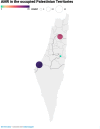Antimicrobial resistance in a protracted war setting: a review of the literature from Palestine
- PMID: 40397600
- PMCID: PMC12172458
- DOI: 10.1128/msystems.01679-24
Antimicrobial resistance in a protracted war setting: a review of the literature from Palestine
Abstract
Antimicrobial resistance (AMR) is an escalating global health crisis. In war-affected regions, where healthcare systems are already compromised, AMR presents an even greater threat. The occupied Palestinian territories (oPt), subjected to chronic war-like conditions, have experienced extensive fragmentation, de-development, and destruction of healthcare. This review maps the existing knowledge regarding AMR carriage and infection in the oPt. We conducted a scoping review using PubMed, CINAHL, Embase, and Web of Science. Findings on the prevalence and suggested drivers of AMR were extracted and analyzed according to the One Health approach. From an initial 1,787 articles, 102 were included in the final analysis. Of these, 91 studies focused on AMR in humans, seven on animals, and four on water contamination. The findings reveal high rates of AMR, with 40% of Klebsiella pneumoniae producing extended-spectrum beta-lactamase (ESBL) and 55% of Streptococcus pneumoniae resistant to penicillin. Additionally, 45.6% of Staphylococcus aureus isolates from cow milk were methicillin-resistant, and 36% of chicken samples contained carbapenem-resistant gram negative bacteria. Significant gaps in the regulation of antibiotic prescription, dispensation, and consumption were reported. Despite the heterogeneity in reporting methods across studies and the inability to perform a meta-analysis, the evidence suggests alarmingly high AMR rates within the oPt. Notably, most studies attributed AMR to local practices, often overlooking broader structural and socio-political drivers. This review underscores the need to contextualize AMR within the environment, particularly under conditions of sustained warfare.IMPORTANCEThis study goes beyond merely reviewing and summarizing data on AMR in the occupied Palestinian territories (oPt), a region enduring chronic war-like conditions. Our work addresses critical gaps in knowledge about AMR in populations affected by war and siege. By contextualizing AMR through a socio-political lens, this study offers a novel perspective. It highlights deeper drivers, including the impact of war on the behaviors and education of patients and doctors, perceptions of antibiotics, the role of humanitarian interventions in fostering antibiotic anarchy, and the overall weakening of the Palestinian healthcare system. Importantly, this review also sets the stage for understanding the existing literature on AMR in the oPt within the context of the ongoing war in Gaza, emphasizing the immediate need for comprehensive strategies to address AMR under conditions of conflict. The insights can inform physicians and policymakers in designing and implementing effective AMR stewardship programs, not only in Palestine but also in other conflict-affected regions.
Keywords: AMR; Palestine; equity; settler colonialism; war.
Conflict of interest statement
The authors declare no conflict of interest.
Figures



Similar articles
-
The burden of bacterial antimicrobial resistance in the WHO African region in 2019: a cross-country systematic analysis.Lancet Glob Health. 2024 Feb;12(2):e201-e216. doi: 10.1016/S2214-109X(23)00539-9. Epub 2023 Dec 19. Lancet Glob Health. 2024. PMID: 38134946 Free PMC article.
-
Global antimicrobial resistance and antibiotic use in COVID-19 patients within health facilities: A systematic review and meta-analysis of aggregated participant data.J Infect. 2024 Jul;89(1):106183. doi: 10.1016/j.jinf.2024.106183. Epub 2024 May 14. J Infect. 2024. PMID: 38754635
-
The WHO Bacterial Priority Pathogens List 2024: a prioritisation study to guide research, development, and public health strategies against antimicrobial resistance.Lancet Infect Dis. 2025 Sep;25(9):1033-1043. doi: 10.1016/S1473-3099(25)00118-5. Epub 2025 Apr 14. Lancet Infect Dis. 2025. PMID: 40245910 Free PMC article.
-
Antibiotic resistance associated with the COVID-19 pandemic: a systematic review and meta-analysis.Clin Microbiol Infect. 2023 Mar;29(3):302-309. doi: 10.1016/j.cmi.2022.12.006. Epub 2022 Dec 9. Clin Microbiol Infect. 2023. PMID: 36509377 Free PMC article.
-
Scholarly Publications and Opinions Through 366-Day War on Gaza (2023-2024): A Scoping Review and Bibliometric Analysis.Int J Health Policy Manag. 2025;14:8809. doi: 10.34172/ijhpm.8809. Epub 2025 Apr 14. Int J Health Policy Manag. 2025. PMID: 40767204 Free PMC article.
References
-
- Akilimali A, Oduoye MO, Balume A, Kachunga D, Luundo P, Sayadi R, Banga S, Aganze A, Ramandizi G, Muhoza B. 2022. Antimicrobial use and resistance in democratic Republic of Congo: implications and recommendations; a mini review. Ann Med Surg (Lond) 80:104183. doi: 10.1016/j.amsu.2022.104183 - DOI - PMC - PubMed
-
- Ahmadzai MA, Shinwari Q, Al-Rasheed AA, Garba B. 2022. Armed conflict and the proliferation of antimicrobial resistance: the situation in war-ravaged Afghanistan. Int J One Health:43–47. doi: 10.14202/IJOH.2022.43-47 - DOI
Publication types
MeSH terms
Substances
LinkOut - more resources
Full Text Sources
Medical

